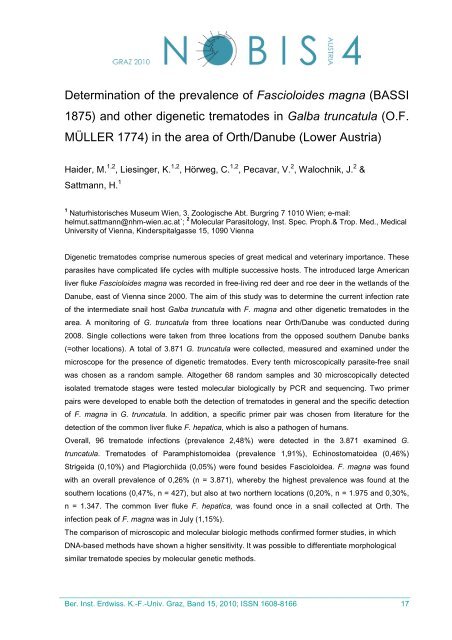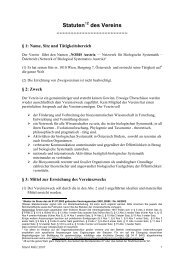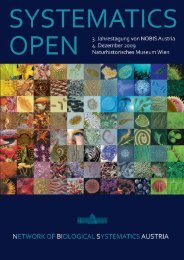4. Jahrestagung von NOBIS Austria 2. - 3. Dezember 2010
4. Jahrestagung von NOBIS Austria 2. - 3. Dezember 2010
4. Jahrestagung von NOBIS Austria 2. - 3. Dezember 2010
Create successful ePaper yourself
Turn your PDF publications into a flip-book with our unique Google optimized e-Paper software.
Determination of the prevalence of Fascioloides magna (BASSI<br />
1875) and other digenetic trematodes in Galba truncatula (O.F.<br />
MÜLLER 1774) in the area of Orth/Danube (Lower <strong>Austria</strong>)<br />
Haider, M. 1,2 , Liesinger, K. 1,2 , Hörweg, C. 1,2 , Pecavar, V. 2 , Walochnik, J. 2 &<br />
Sattmann, H. 1<br />
1 Naturhistorisches Museum Wien, <strong>3.</strong> Zoologische Abt. Burgring 7 1010 Wien; e-mail:<br />
helmut.sattmann@nhm-wien.ac.at´; 2 Molecular Parasitology, Inst. Spec. Proph.& Trop. Med., Medical<br />
University of Vienna, Kinderspitalgasse 15, 1090 Vienna<br />
Digenetic trematodes comprise numerous species of great medical and veterinary importance. These<br />
parasites have complicated life cycles with multiple successive hosts. The introduced large American<br />
liver fluke Fascioloides magna was recorded in free-living red deer and roe deer in the wetlands of the<br />
Danube, east of Vienna since 2000. The aim of this study was to determine the current infection rate<br />
of the intermediate snail host Galba truncatula with F. magna and other digenetic trematodes in the<br />
area. A monitoring of G. truncatula from three locations near Orth/Danube was conducted during<br />
2008. Single collections were taken from three locations from the opposed southern Danube banks<br />
(=other locations). A total of <strong>3.</strong>871 G. truncatula were collected, measured and examined under the<br />
microscope for the presence of digenetic trematodes. Every tenth microscopically parasite-free snail<br />
was chosen as a random sample. Altogether 68 random samples and 30 microscopically detected<br />
isolated trematode stages were tested molecular biologically by PCR and sequencing. Two primer<br />
pairs were developed to enable both the detection of trematodes in general and the specific detection<br />
of F. magna in G. truncatula. In addition, a specific primer pair was chosen from literature for the<br />
detection of the common liver fluke F. hepatica, which is also a pathogen of humans.<br />
Overall, 96 trematode infections (prevalence 2,48%) were detected in the <strong>3.</strong>871 examined G.<br />
truncatula. Trematodes of Paramphistomoidea (prevalence 1,91%), Echinostomatoidea (0,46%)<br />
Strigeida (0,10%) and Plagiorchiida (0,05%) were found besides Fascioloidea. F. magna was found<br />
with an overall prevalence of 0,26% (n = <strong>3.</strong>871), whereby the highest prevalence was found at the<br />
southern locations (0,47%, n = 427), but also at two northern locations (0,20%, n = 1.975 and 0,30%,<br />
n = 1.347. The common liver fluke F. hepatica, was found once in a snail collected at Orth. The<br />
infection peak of F. magna was in July (1,15%).<br />
The comparison of microscopic and molecular biologic methods confirmed former studies, in which<br />
DNA-based methods have shown a higher sensitivity. It was possible to differentiate morphological<br />
similar trematode species by molecular genetic methods.<br />
_____________________________________________________________________________<br />
Ber. Inst. Erdwiss. K.-F.-Univ. Graz, Band 15, <strong>2010</strong>; ISSN 1608-8166 17






